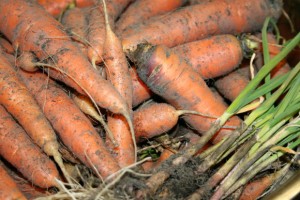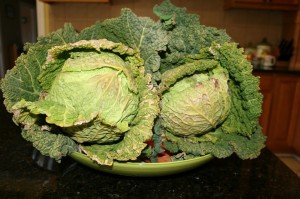 |
| Harvest of Carrots and Garlic Chives |
 |
| Savoy Cabbage |
The winter vegetable harvest this year was wonderful, and quite a delicious surprise. In the fall, I’d planted carrots, turnips, beets, cabbage, broccoli and cauliflower. We enjoyed the broccoli, but the cauliflower never took off, and then my father in law got sick, and after he died we didn’t have the energy to do much. So I let nature take its course and let the garden die back naturally. We ate some of the broccoli but I just left the rest.
But then as I was pulling out the dead stuff, I realized that under some mushy outer leaves, two rather large heads of savoy cabbage were still there. I dug around in one of the raised beds into what I thought were weeds, only to find carrots – 20 pounds of them! The tops of the carrots had turned purple where the frost nipped it, but otherwise they were fine. We also found some garlic chives I’d forgotten to pull out of the asparagus bed.
Last night for supper, I made a roast chicken, cabbage and onions, and baked potatoes. Everything but the chicken I grew myself not 20 feet from the kitchen. The previous evening, I served carrots and turnips also grown in my garden. And lunch consisted of a delicious salad topped with garlic chives and canned peppers that I had grown in the garden. Unfortunately, the lettuce isn’t up yet, or else I’d have enjoyed a home-grown meal for lunch, too.
There really is something wonderful about growing your own food. I love the fact that turnips, probably one of the easiest vegetables I have ever grown, cost about 69 cents or more per pound in the grocery store. I must harvest 10, 20 pounds or more. The same with peppers – an abundance of peppers of all types grows easily and readily in my garden. Those same peppers cost around 99 cents per pound. I can also grow my garden using organic gardening methods as I choose to do.
If you haven’t done so already, plan your vegetable garden now. Soon it will be time to plant, and there’s a lot you can do now to get ready.




